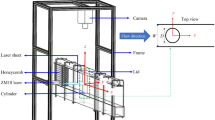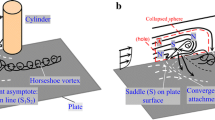Abstract
Juncture flow is a classical fluid mechanics problem having wide applications in both aero and hydro dynamics. The flow separates upstream of the obstacle due to the adverse pressure gradient generated by it, with the formation of the vortical structure called “horseshoe vortex.” The current study is carried out for an elliptical leading edge obstacle placed on a flat plate to investigate the horseshoe vortex for a range of Reynolds number (ReW) based on maximum width (W) for which the incoming boundary layer is laminar. Four different types of horseshoe vortex systems were found: the steady, amalgamation, transition and breakaway. The transition vortex system is one after which the vortex system changes from amalgamation to breakaway. In this phase the vortex system alternatively undergoes both amalgamation and breakaway vortex cycles. The effect of variation in the chord wise shape of the obstacle is investigated. The quantitative measurements of PIV show that the vortex system does not undergo any significant change for different chord lengths of the model with the fixed aspect ratio and maximum width. The most upstream saddle point is also studied for steady horseshoe vortex region and found that it is the “saddle of attachment” where flow attaches to the plate surface instead of separating from it.
Similar content being viewed by others
References
R. Schwind, The three dimensional boundary layer near a strut, Gas Turbine Laboratory Report, MIT (1962).
R. S. Norman, On obstacle generated secondary flows in laminar boundary layers and transition to turbulence, Ph.D. Dissertation, Illinois Institute of Technology, Chicago, IL, USA (1972).
C. J. Baker, The laminar horseshoe vortex, Journal of Fluid Mechanics, 95 (1979) 347–367.
C. J. Baker, The oscillation of horseshoe vortex systems, Journal of Fluids Engineering, 113 (1991) 489–495.
M. R. Visbal, Structure of laminar juncture flows, AIAA J., 29(8) (1991) 1273–1282.
M. J. Khan, A. Ahmed and J. R. Trosper, Dynamics of the juncture vortex, AIAA J., 33(7) (1995) 1273–78.
C. V. Seal, C. R. Smith and J. D. A. Walker, Dynamics of the vorticity distribution in end wall junctions, AIAA J., 35(6) (1997) 1041–47.
H. Zhang and Z. Y. Lu, The flow characteristics and its meliorationof swept wing/body interference, (Chinese) J. of BeijingUniv. of Aero. and Astro., 26(5) (2000) 592–595.
Q. D. Wei, G. Chen and X. D. Du, An experimental study on the structure of juncture flows, J. Vis., 3–4 (2001) 341–48.
R. L. Simpson, Junction flows, Annual Review of Fluid Mechanics, 33 (2001) 415–443.
C. Lin, P. H. Chiu and S. J. Shieh, Characteristics of horseshoe vortex system near a vertical plate-base plate juncture, Experimental Thermal and Fluid Science, 27 (2002) 25–46.
C. Lin, W. J. Lai and K. A. Chang, Simultaneous particle image velocimetry and laser Doppler velocimetry measurements of periodical oscillatory horseshoe vortex system near square cylinder-base plate juncture, J. of Eng. Mech., 129(10) (2003) 1173–1188.
M. J. Khan and A. Ahmed, Topological model of flow regimes in the plane of symmetry of a surface-mounted obstacle, Physics of Fluids, 17 (2005) 045101.
Rodríguez y Domínguez M. Romero-Méndez, R., Ramospaláu, M. and Pérez-Gutiérrez, F. G., The laminar horseshoe vortex upstream of a short-cylinder confined in a channel formed by a pair of parallel plates, J. Vis., 9(3) (2006) 309–318.
R. Rifki, A. Ahmed and M. J. Khan, Effect of aspect ratio on the end-wall flow of a streamlined cylinder, 23rd AIAA applied aerodynamics conference (2005).
Q. D. Wei, J. M. Wang, G. Chen, Z. B. Lu and W. T. Bi, Modification of junction flows by altering the section shapes of the cylinders, J. Vis., 11(2) (2008) 115–124.
H. Zhang, L. Z. Yong and S. Shengdong. The experimental study on unsteady horseshoe vortex structure in juncture flow with PIV, (Chinese) Journal of Theoretical and Applied Mechanics, 40(2) (2008) 171–78.
M. Y. Younis, H. Zhang, B. Hu, M. A. Sohail and Zaka Muhammad, Laminar Horseshoe vortex for a triangular cylinder flat plate juncture, Proceedings of the Sixth International Conference on Fluid Mechanics AIP Conf. Proc. Volume, (2011) 113–115.
E. C. Maskell, Flow separation in three dimensions, RAE Aero. Report, (1955) 2655–2673.
M. J. Lighthill, Laminar boundary layers, In: Rosenhead, L. (ed) Oxford Univ. Press (1963).
K. C. Wang, Separation patterns of boundary layer over an inclined body of revolution, AIAA. J., 10(8) (1972) 1044–1050.
K. C. Wang, Separation of three-dimensional flow, MML, (1976) 76–54.
M. R. Visbal, Structure of laminar juncture flows, AIAA J., 29(8) (1991) 1273–1282.
C. M. Hung, C. H. Sung and C. L. Chen, Computation of saddle point of attachment, AIAA J., 30(6) (1992) 1561–1569.
C. L. Chen and C. M. Hung, Numerical study of juncture flows, AIAA J., 30(7) (1992) 1800–1807.
R. L. Puhak, A. T. Degani and J. D. A. Walker, Unsteady separation and heat transfer upstream of obstacles, Journal of Fluid Mechanics, 305 (1995) 1–27.
D. P. Rizetta, Numerical simulation of turbulent cylinder juncture flow fields, AIAA J., 32(6) (1994) 1113–1119.
H. Chen, Assessment of a Reynolds stress closure model for appendage-hull junction flows, Journal of Fluid Engineering, 11l7 (1995) 557–563.
M. D. Coon and M. Tobak, Experimental study of saddle point of attachment in laminar juncture flow, AIAA J., 33(22) (1995) 88–92.
H. Zhang, M. Y. Younis, B. Hu, H. Wang and X. Wang, Investigation of attachment saddle point structure of 3-D separation in laminar juncture flow using PIV, J. Vis., 15 (2012) 214–252.
X. Wang, H. Zhang, H. Wang and L. Fu, New 3-D separation structure in juncture flows, J Beijing Univ Aeronaut Astronaut, 36(12) (2010) 1461–1466 (in Chinese).
H. X. Zhang, Structural analysis of separated flows and vortex motion, National Defense Industry Press, Beijing 2005 (in Chinese).
Author information
Authors and Affiliations
Corresponding author
Additional information
Recommended by Associate Editor Simon Song
M. Y. Younis is a Ph.D. candidate at Baihang University (BUAA), Beijing, China, doing research on different aspects of juncture flows, with main focus on topology and control of horseshoe vortex. His B.Sc, in Mechanical Engineering is from UET Taxila, Pakistan and M.S. in Fluid Mechanics from Beihang University (BUAA), China.
Rights and permissions
About this article
Cite this article
Younis, M.Y., Zhang, H., Hu, B. et al. Investigation of different aspects of laminar horseshoe vortex system using PIV. J Mech Sci Technol 28, 527–537 (2014). https://doi.org/10.1007/s12206-013-1120-9
Received:
Revised:
Accepted:
Published:
Issue Date:
DOI: https://doi.org/10.1007/s12206-013-1120-9




